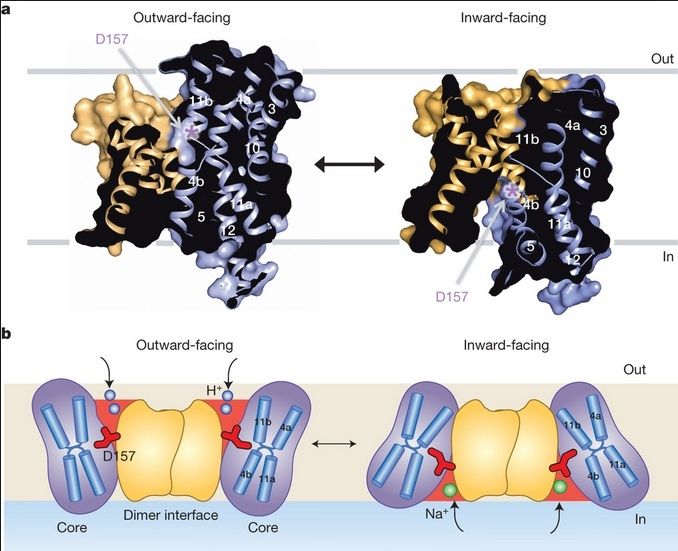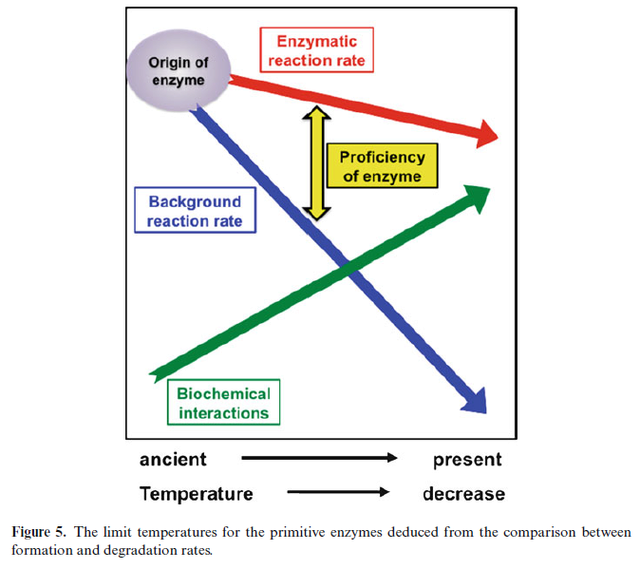https://reasonandscience.catsboard.com/t1394-the-hydrothermal-vent-hypothesis-and-why-it-fails
Dr. Stanley L. Miller, University of California San Diego 14
What about submarine vents as a source of prebiotic compounds?
I have a very simple response to that . Submarine vents don't make organic compounds, they decompose them. Indeed, these vents are one of the limiting factors on what organic compounds you are going to have in the primitive oceans. At the present time, the entire ocean goes through those vents in 10 million years. So all of the organic compounds get zapped every ten million years. That places a constraint on how much organic material you can get. Furthermore, it gives you a time scale for the origin of life. If all the polymers and other goodies that you make get destroyed, it means life has to start early and rapidly. If you look at the process in detail, it seems that long periods of time are detrimental, rather than helpful.
https://web.archive.org/web/20080518054852/http://www.accessexcellence.org/WN/NM/miller.php
http://www.molevol.de/gallery/Origin-of-life_high.mp4
The high concentrations of water on the early Earth would have diluted reactants, diffused away products, AND inhibited condensation reactions 10
A lot of origin-of-life reactions involve getting rid of water
Kevin Zahnle, a planetary scientist at the NASA Ames Research Center at Moffett Field, Calif.
The formation of the monomers does not imply the formation of their polymers, which has its own unique set of challenges in a prebiotic context. All three types of biopolymers are formed via condensation polymerization, producing a single water molecule per bond formed. Water is the solvent of life, and geologists predict that a significant ocean volume existed on the prebiotic Earth. However, polymerization reactions in aqueous media drive the polymerization reaction toward the reactants, via hydrolysis, since water is a product of the reaction. In origins of life research, this is referred to as the “water problem”. Dilution is another challenge for prebiotic polymerization, due the large volume of the ocean and the relatively small amount of monomer that would have been present. 12
RNA has been called a “prebiotic chemist's nightmare” because of its combination of large size, carbohydrate building blocks, bonds that are thermodynamically unstable in water, and overall intrinsic instability. 13 Many bonds in RNA are thermodynamically unstable with respect to hydrolysis in water, creating a “water problem”. Finally, some bonds in RNA appear to be “impossible” to form under any conditions considered plausible for early Earth.
The argument follows, that perhaps life first originated in the ocean, then over time evolved enough to come up to the surface to photosynthesize without getting burned by UVR. But even this theory has its own problems. Namely the problem of hydrolysis or “water-splitting.” The US National Academy of Sciences explains, “In water, the assembly of nucleosides from component sugars and nucleobases, the assembly of nucleotides from nucleosides and phosphate, and the assembly of oligonucleotides from nucleotides are all thermodynamically uphill in water. Two amino acids do not spontaneously join in water. Rather, the opposite reaction is thermodynamically favored at any plausible concentrations: polypeptide chains spontaneously hydrolyze in water, yielding their constituent amino acids,”. Physicist Richard Morris concurs, “… water tends to break chains of amino acids. If any proteins had formed in the ocean 3.5 billion years ago, they would have quickly disintegrated,” (Morris, 167). Additionally, the cytoplasm of living cells contains essential minerals of potassium, zinc, manganese and phosphate ions. If cells manifested naturally, these minerals would need to be present nearby. But marine environments do not have widespread concentrations of these minerals (Switek). Thus, it is clear, life could not have formed in the ocean. 2
A requirement for ultraviolet irradiation to generate hydrated electrons would rule out deep sea environments. This, along with strong bioenergetic and structural arguments, suggests that the idea that life originated at vents should, like the vents themselves, remain ‘In the deep bosom of the ocean buried’. 11
If this hypothesis were true, we would have to be able to find the development of proto-cells at all stages at these vents. Even today. Why would the origin of life have happened only once? It the alkaline hydrothermal vents offer today the same environment as 3,5 bio years ago and favor the emergence of life, we should observe this being a process happening constantly, and see protocells in all stages of development, and fully formed cells nearby. There is no trace of it. Why ?!!
https://reasonandscience.catsboard.com/t1394-the-hydrothermal-vent-hypothesis-and-why-it-fails
Given an ocean full of small molecules of the types likely to be produced on a pre biological earth with the types of processes postulated by the origin of life enthusiasts, we must next approach the question of polymerization. This question poses a two-edged sword: we must first demonstrate that macromolecule synthesis is possible under pre biological conditions, then we must construct a rationale for generating macromolecules rich in the information necessary for usefulness in a developing precell.
The synthesis of proteins and nucleic acids from small molecule precursors represents one of the most difficult challenges to the model of prebiological evolution. There are many different problems confronted by any proposal. Polymerization is a reaction in which water is a product. Thus it will only be favored in the absence of water. The presence of precursors in an ocean of water favors depolymerization of any molecules that might be formed. Careful experiments done in an aqueous solution with very high concentrations of amino acids demonstrate the impossibility of significant polymerization in this environment.
Polymer formation in aqueous environments would most likely have been necessary on early Earth because the liquid ocean would have been the reservoir of amino acid precursors needed for protein synthesis. 3
Sidney Fox, an amino acid chemist, and one of my professors in graduate school, recognized the problem and set about constructing an alternative. Since water is unfavorable to peptide bond formation, the absence of water must favor the reaction. Fox attempted to melt pure crystalline amino acids in order to promote peptide bond formation by driving off water from the mix. He discovered to his dismay that most amino acids broke down to a tarry degradation product long before they melted. After many tries he discovered two of the 20 amino acids, aspartic and glutamic acid, would melt to a liquid at about 200oC. He further discovered that if he were to dissolve the other amino acids in the molten aspartic and glutamic acids, he could produce a melt containing up to 50% of the remaining 18 amino acids. It was no surprise then that the amber liquid, after cooking for a few hours , contained polymers of amino acids with some of the properties of proteins. He subsequently named the product proteinoids. The polymerized material can be poured into an aqueous solution, resulting in the formation of spherules of protein-like material which Fox has likened to cells. Fox has claimed nearly every conceivable property for his product, including that he had bridged the macromolecule to cell transition. He even went so far as to demonstrate a piece of lava rock could substitute for the test tube in proteinoid synthesis and claimed the process took place on the primitive earth on the flanks of volcanoes. However, his critics as well as his own students have stripped his credibility.
“It’d be like trying to make life evolve from hot Coca-Cola.” Stanley Miller of Miller-Urey experiment fame told Discover Magazine in 1992 that overall, “The vent hypothesis is a real loser. I don’t understand why we even have to discuss it.” One difficulty is that the oldest known fossils are stromatolites, clumps of bacteria from 3.5 billion years ago, which suggests that life began in shallow seas, not deep ones.
"We posit that the primordial lipids coating the inorganic cells were synthesised by Fischer-Tropsch-type reactions in hydrothermal systems." 1
Submarine hydrothermal systems (SHSs) have been thought of as a suitable environment for the origin of life subsequent to the abiotic synthesis of organic molecules. However, it has been pointed out that bioorganic molecules, such as amino acids, are easily degraded at a high temperature, and thus not likely to survive for the next step of chemical evolution in a SHS environment. 3
The problem with monomers is bad enough,but it is worse with polymers,e.g.,RNA and DNA (Lindahl1993),whose stability in the absence of efficient repair enzymes is too low to maintain genetic integrity iyperthermophiles. RNA and DNA are clearly too unstable to exist in a hot prebiotic environment.The existence of an RNA world with ribose appears to be incompatible with the idea of a hot origin of life. 4
Hydrothermal vents are hot, inhospitable places and the DNA of microbes that live there is continually being damaged, such that the microbes must have sophisticated error-protecting and correcting systems to survive. They are not at all simple and do not provide any sort of viable model for explaining the origin of life 5
fatty acids are formed along the face of a geyser. Research has shown that some minerals can catalyze the stepwise formation of hydrocarbon tails of fatty acids from hydrogen and carbon monoxide gases -- gases that may have been released from hydrothermal vents. Fatty acids of various lengths are eventually released into the surrounding water. 6
Unfortunately for both warm-pond and hydrothermal-vent theorists, the extreme heat has proven to be a major downfall of their theories. This is because high temperatures would accelerate the breakdown of amino acids, just as cooking meat breaks down the bonds, causing meat to become more tender. 9
The discovery of hydrothermal vents at oceanic ridge crests has spawned several origin-of-life hypotheses. It seemed an attractive suggestion that, given the dissolved gases issuing from the vents, with hydrothermal mixing there would emerge peptides, nucleotides and even protocells of some sort. Miller and Bada, however, dispute the plausibility.1
“This proposal, however, is based on a number of misunderstandings concerning the organic chemistry involved. An example is the suggestion that organic compounds were destroyed on the surface of the early Earth by the impact of asteroids and comets, but at the same time assuming that organic syntheses can occur in hydrothermal vents. The high temperatures in the vents would not allow synthesis of organic compounds, but would decompose them, unless the exposure time at vent temperatures was short. Even if the essential organic molecules were available in the hot hydrothermal waters, the subsequent steps of polymerization and the conversion of these polymers into the first organisms would not occur as the vent waters were quenched to the colder temperatures of the primitive oceans.”
[E]xperiments simulating the conditions of hydrothermal vents have only succeeded in producing RNA chains a few monomers long.
https://pubmed.ncbi.nlm.nih.gov/26154881/
"Therefore, unless the origin of life took place extremely rapidly (<100 yr), we conclude that a high-temperature origin of life may be possible, but it cannot involve adenine, uracil, guanine, or cytosine. The rates of hydrolysis at 100°C also suggest that an ocean-boiling asteroid impact would reset the prebiotic clock, requiring prebiotic synthetic processes to begin again."
https://www.ncbi.nlm.nih.gov/pmc/articles/PMC20907/
1) http://creation.com/origin-of-life-critique
Miller, S.L. and Bada, J.L., Submarine hot springs and the origin of life, Nature 334:609–611, 1988.
2) https://matthew2262.wordpress.com/category/biology-related/
3) http://www.csj.jp/journals/bcsj/bc-cont/b12may/85_20110349.html
4) http://physwww.mcmaster.ca/~higgsp/3D03/MillerHighTemp.pdf
5) http://creation.com/origin-of-life
6) http://exploringorigins.org/fattyacids.html
7) http://christiananswers.net/q-crs/abiogenesis.html
8 http://creation.com/why-the-miller-urey-research-argues-against-abiogenesis
9) Sarfati, J., Origin of life: the polymerization problem, TJ 12(3):281–284, 1998.
10) http://web.pdx.edu/~niles/Lehman_Lab_at_PSU/Chem_460_560_files/CH460_Sp12_slides_final.pdf
11) Opinion: Studies on the origin of life — the end of the beginning
12. http://www.mdpi.com/2227-9717/3/2/309/pdf.
13. http://pubs.acs.org.sci-hub.cc/doi/abs/10.1021/ar200332w
14. https://web.archive.org/web/20080518054852/http://www.accessexcellence.org/WN/NM/miller.php
Last edited by Otangelo on Sun Aug 25, 2024 7:52 am; edited 31 times in total




